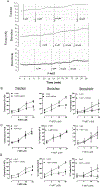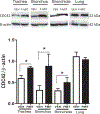Mitochondrial N-formyl peptides cause airway contraction and lung neutrophil infiltration via formyl peptide receptor activation
- PMID: 26923940
- PMCID: PMC9731398
- DOI: 10.1016/j.pupt.2016.02.005
Mitochondrial N-formyl peptides cause airway contraction and lung neutrophil infiltration via formyl peptide receptor activation
Abstract
Respiratory failure is a common characteristic of systemic inflammatory response syndrome (SIRS) and sepsis. Trauma and severe blood loss cause the release of endogenous molecules known as damage-associated molecular patterns (DAMPs). Mitochondrial N-formyl peptides (F-MITs) are DAMPs that share similarities with bacterial N-formylated peptides, and are potent immune system activators. Recently, we observed that hemorrhagic shock-induced increases in plasma levels of F-MITs associated with lung damage, and that antagonism of formyl peptide receptors (FPR) ameliorated hemorrhagic shock-induced lung injury in rats. Corroborating these data, in the present study, it was observed that F-MITs expression is higher in plasma samples from trauma patients with SIRS or sepsis when compared to control trauma group. Therefore, to better understand the role of F-MITs in the regulation of lung and airway function, we studied the hypothesis that F-MITs lead to airway contraction and lung inflammation. We observed that F-MITs induced concentration-dependent contraction in trachea, bronchi and bronchioles. However, pre-treatment with mast cells degranulator or FPR antagonist decreased this response. Finally, intratracheal challenge with F-MITs increased neutrophil elastase expression in lung and inducible nitric oxide synthase and cell division control protein 42 expression in all airway segments. These data suggest that F-MITs could be a putative target to treat respiratory failure in trauma patients.
Keywords: Airway and lung inflammation; Mitochondrial N-formyl peptides; Trauma.
Copyright © 2016 Elsevier Ltd. All rights reserved.
Figures





References
-
- American College of Chest Physicians/Society of Critical Care Medicine, American College of Chest Physicians/Society of Critical Care Medicine Consensus Conference: definitions for sepsis and organ failure and guidelines for the use of innovative therapies in sepsis, Crit. Care Med. 20 (1992) 864–874. - PubMed
-
- Dicker RA, Morabito DJ, Pittet JF, Campbell AR, Mackersie RC, Acute respiratory distress syndrome criteria in trauma patients: why the definitions do not work, J. Trauma 57 (2004) 522–526. - PubMed
-
- Armour CL, Black JL, Johnson PR, Vincenc KS, Berend N, Formyl peptide-induced contraction of human airways in vitro, J. Appl. Physiol. 60 (1985) 141–146. - PubMed
Publication types
MeSH terms
Substances
Grants and funding
LinkOut - more resources
Full Text Sources
Other Literature Sources

